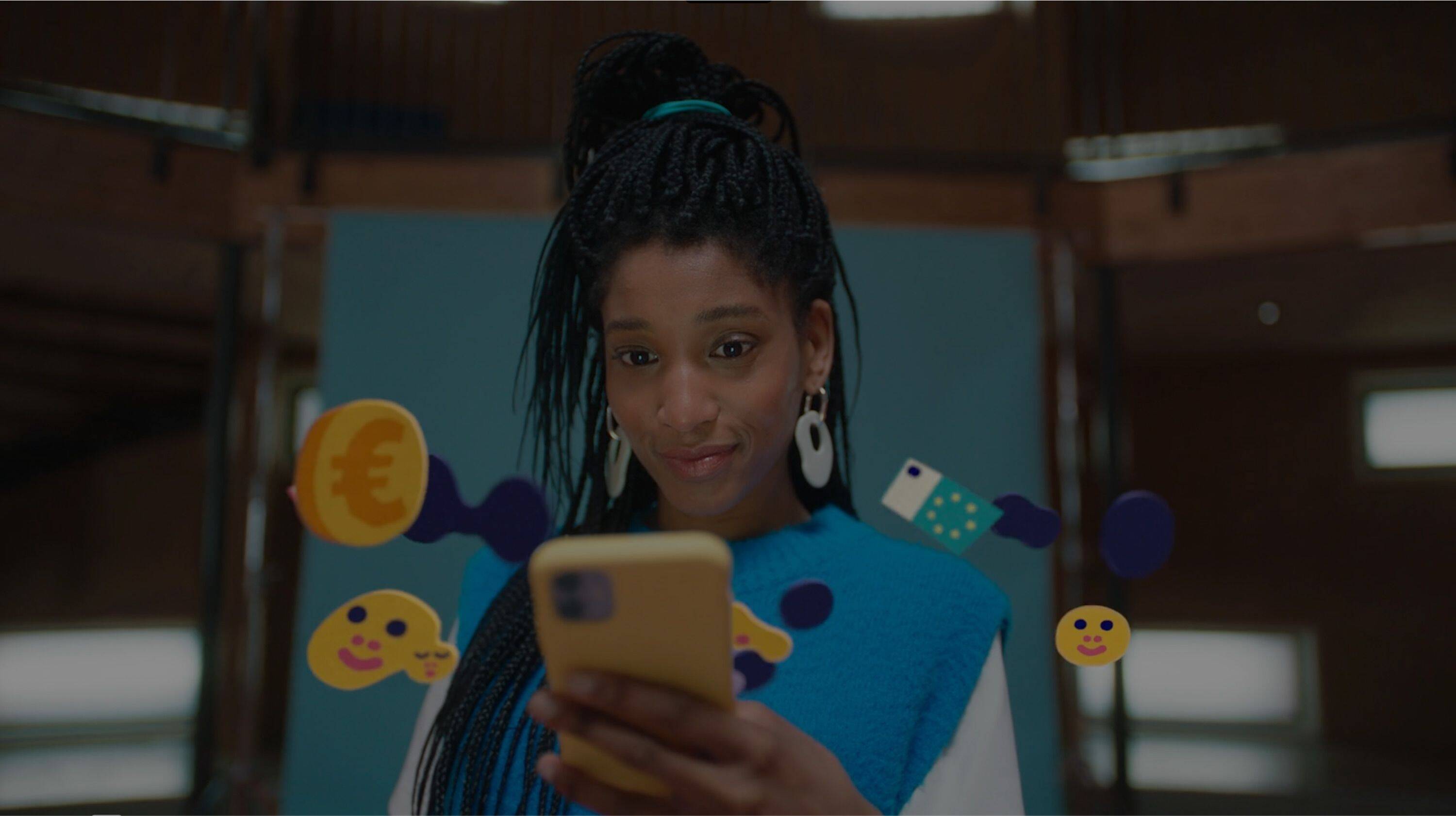Start

Start





Turning uncertainty into an opportunity for brand loyalty
transaction
beyond
Building
Previous
Previous
As people are forced to deal with long-lasting uncertainty, brand loyalty is at risk.
Years of uncertainty are taking their toll on people. In June 2025, British households experiencing ‘multi-stress’ hit the highest levels seen since the 2008 financial crash.
Downward economic shifts are leaving people anxious about their finances, ongoing geopolitical tensions are heightening polarisation, and developments in technology are leaving people worried about job security. These ever-changing and volatile environments are creating a sense of unease that underpins everyday life.
Many also aren’t optimistic about the future – 79% of UK adults expect children in their country to be worse off financially than their parents when they grow up (higher than the global average of 57%).
of UK shoppers say private label products satisfy their needs just as well as branded products, while 42% are switching to own brands or cheaper alternatives
UK consumers are ‘extremely worried’ about the rising cost of living (up five percentage points since 2024)
Previous
Previous
of online UK shoppers believe that online retailers prioritise sales over overall customer experience
Previous
Previous
of Britons have moderate or higher feelings of grievance against businesses, government, and the rich

Previous
Previous
Previous
Previous
Previous
Previous
An analysis technique that surfaces the most important and prevalent themes from social research, using them to build meaningful insights and tangible actions for businesses.
Clustering
An in-depth consultation with Vinay Parmar, a thought leader in brand loyalty, to contextualise and steer research. Vinay is the Managing Director of Customer Whisperers, a consultancy that helps brands turn everyday interactions into lasting loyalty. With over 30 years of experience, he’s recognised as one of the UK’s leading voices on the topic.
Vinay Parmar
Managing Director of Customer Whisperers,
Brand advocacy expert

Input
Internal and external research drawing on Canvas8's proprietary insight Library of more than 41,000 articles, as well as third-party sources, reports, and statistics. This step mapped out the state of brand loyalty and uncertainty in the UK, the macro shifts influencing them, and identified opportunities for brands to win loyalty by better meeting people’s needs.
Previous
Previous
People are looking for brands that can meet their deeper emotional needs
People want brands to help them create meaningful connections
People are looking for loyalty programmes that go beyond transactional value
People are rethinking the value and quality of the products they buy
People are looking for brands that cut through the noise of online spaces
Previous
Previous
of Britons want to find unique brands using AI
of Britons would be open to making purchases using AI technology in the future
of Britons say AI helps inspire them when buying outfits, meals, and other purchases
It’s no secret we live in a tech-forward world. In fact, 75% of Britons say they check their social media apps immediately upon waking up. But this is contributing to digital fatigue, as people face a barrage of notifications, advertisements, and information. Almost half (46%) of UK online shoppers feel overwhelmed by the amount of information or options on retail websites. And it isn’t just online – as the world feels more uncertain, people are experiencing decision paralysis, faced with too much choice and not enough trustworthy guidance.
In a fast-paced and disorienting world, people will continue to come back to brands that offer simplified experiences. New technology holds great potential for facilitating this; 80% of people globally who haven’t used AI when shopping before say they’re interested in trying it. From brand discovery to product selection and even payments, they’re open to it being a source of support across different moments in the purchase journey.
Previous
Previous

Jonathan Healey
Group Technology Director, IDHL

Vinay Parmar
Managing Director of Customer Whisperers, Brand advocacy expert
Previous
Previous
Leading pharmacy chain, Well Pharmacy, wanted to strengthen their service offering and counteract low repeat purchase rates. To increase retention and lifetime value growth rates, we implemented a targeted consultation-page capture, segmented cart recovery and replenishment campaigns. Our segmented, tailored email strategy recovered 533 abandoned carts, delivered over £150k since April and increased return purchase rate by 20%.

Jordan Emmett-Connelly
Head of Email Marketing and On-site Acquisition, IDHL
Previous
Previous


Previous
Previous
say the same of product/service quality
of British shoppers say that price is ‘very/somewhat important’
As the cost of living crisis continues to bite, there’s a tension emerging between price and quality. The rise of platforms like TikTok Shop has given people access to lower prices, and dupes – once considered cheap imitations – are increasingly a symbol of being financially savvy. However, people also want to spend their money on something that lasts. It’s why 68% of British shoppers say they’re willing to pay more for quality products.
This tension presents an opportunity for brands. While the focus on price isn’t going anywhere, especially in the face of economic stress, neither is the hunt for quality. As more people adopt a ‘buy nice, don’t pay twice’ mentality, brands can lean in, highlighting qualities like durability, craftsmanship, and longevity as a true form of value.
Previous
Previous

Vinay Parmar
Managing Director of Customer Whisperers, Brand advocacy expert
Previous
Previous
A survey conducted across UK, France, and Italy reported how TikTok is reshaping luxury shopping behaviours, with peer-driven content acting as the catalyst for purchases. TikTok's immersive, discovery-driven experience allow users to explore products through engaging user-generated content, making shopping feel more like entertainment. Brands that leverage this platform's capabilities can build credibility, long-term resonance, and loyalty.

Megan Graham
Head of Social, IDHL
Previous
Previous


Previous
Previous
of UK shoppers turn to loyalty programmes during economic uncertainty
To keep customers returning, many businesses are focusing on loyalty schemes – 88% of UK Shopify brands cite loyalty programmes as key for driving revenue. But it’s clear that loyalty can take many forms. For some shoppers, the decision to return to a brand is emotional, while others do it out of habit or economic necessity, something increasingly common amid ongoing financial instability. Relevance is key – 65% of shoppers would skip a loyalty scheme entirely if its rewards don’t meet their needs.
Ultimately, making customers feel seen and understood is essential. A well‑designed loyalty programme creates more than repeat transactions; it builds an immersive ecosystem where customers can fully engage with a brand’s world. It becomes a powerful channel for sharing the stories and values that define the brand’s identity. And when done right, the effect is reciprocal: the programme weaves itself into customers’ lives, offering insights that help them better understand their own habits, preferences, and what they truly value.
Previous
Previous

Vinay Parmar
Managing Director of Customer Whisperers, Brand advocacy expert
Previous
Previous
Selfridges has introduced ‘Selfridges Unlocked’, a free‑to‑join loyalty programme that recognises the time customers invest in the store as much as the money they spend. Points earned can be redeemed across unique brand experiences, from the Selfridges cinema to its restaurants. The initiative demonstrates a shift towards rewarding meaningful engagement, inviting customers to deepen their connection with the brand and immerse themselves further in the Selfridges world.
Donald Russell, a specialist Scottish Butcher holding the prestigious Royal Warrant, chose IDHL to increase AOV, customer retention and regularity of orders. We developed their promotional offering and free-choice mechanics ahead of the seasonal peak for Valentine’s Day. Our bespoke bundle solution allowed customers to choose their own starters, mains, sides, and desserts so they could get exactly what they wanted at a great dine in price. In the first 24 hours of the launch, the Valentine’s Dine In promotion accounted for 1/3 of orders taken. It has been used for multiple promotions since with large success.
Previous
Previous


Previous
Previous
Britons are interested in joining a community around a specific brand
Lingering impacts from the pandemic, remote working, and loss of third spaces are just some of the factors contributing to the loneliness epidemic in the UK. In 2025, three in ten adults say they feel lonely ‘sometimes or often’. To counteract this, they're exploring new ways to connect with others who have shared interests. Just take the rise of online groups for creatives, run clubs for Gen Zers, and fandom-themed club nights like Swiftogeddon.
It means there’s an opportunity for businesses to build connections with their audiences beyond the products they sell. Brands like Lululemon have underpinned their success through an active and engaged community, offering third spaces and events for people to connect and forge new relationships. With 90% of people in relationships and 88% of singletons saying quality is more important than quantity when it comes to friends, those who can facilitate the creation of deeper, lasting connections will land especially well.
Previous
Previous

Vinay Parmar
Managing Director of Customer Whisperers, Brand advocacy expert
Previous
Previous
Charlotte Tilbury's collaboration with Genshin Impact exemplifies how integrating gaming with commerce can cultivate community and brand loyalty. By offering limited-edition beauty bundles with in-game rewards, Charlotte Tilbury taps into gaming culture. This strategy not only broadens their audience but also fosters a sense of belonging among consumers, encouraging repeat engagement and strengthening brand affinity.
Medichecks chose IDHL to craft a social-first TikTok strategy that engaged their target audience. Audience research identified key interests and keywords, and we created informative, eye-catching video content that encourages users to explore the site. There was instant engagement upon launch, resulting in successful returns. With this new strategy in place, Medichecks is poised to expand into TikTok shop and increase visibility amongst their community using TikTok Search campaigns.
Previous
Previous


Previous
Previous
of Britons say they prioritise spending on experiences over material items
Algorithms have given way to a world where trends move at lightning speeds and one viral video can lead to queues around the block. As a result, things that once felt unique now feel somewhat ubiquitous. This constant churn has led to a growing sense of fatigue, as shoppers begin to question whether acquiring more ‘stuff’ is really as satisfying as they once thought.
Instead, people are looking to spend on experiences that feel immersive, transformative, and unique. In fact, 29% of Britons aged 18 to 34 say they plan to prioritise memorable experiences over the next three years. But authenticity is key, with 45% of British adults saying that pop-up events are just ‘expensive Instagram opportunities’. Within this context, brands can build loyalty by tapping into people’s deeper emotional needs, offering something that feels rewarding beyond monetary value and pure aesthetics.
Previous
Previous

Vinay Parmar
Managing Director of Customer Whisperers, Brand advocacy expert
Previous
Previous
The US-based hotel chain launched a rewards platform that allows members to spend points bidding on exclusive experiences. Options include attending the sold-out Vans Warped Tour, riding on the Zamboni during a New York Rangers game, and a meet and greet at a Radio City Rockettes concert. It creates a deeper relationship with customers by giving them lasting memories that would be difficult to access without its loyalty scheme.
After taking note of the popularity of self-help and upskilling podcasts on their platform, Spotify has launched video-based learning courses. Available in the UK, the content is based around four main themes: make music, get creative, healthy living, and learn business. By tapping into people’s interests, the content works to foster continued engagement while also helping fuel a sense of progression and achievement.
Previous
Previous
from your customers?


Previous
Previous


community

incentives

investments

Previous
Previous
We help brands deepen loyalty and create value that lasts. Get in touch to see how we can do the same for you.
Start

Start





Turning uncertainty into an opportunityfor brand loyalty
transaction
beyond
Building
Previous
Previous
As people are forced to deal with long-lasting uncertainty, brand loyalty is at risk.
Years of uncertainty are taking their toll on people. In June 2025, British households experiencing ‘multi-stress’ hit the highest levels seen since the 2008 financial crash.
Downward economic shifts are leaving people anxious about their finances, ongoing geopolitical tensions are heightening polarisation, and developments in technology are leaving people worried about job security. These ever-changing and volatile environments are creating a sense of unease that underpins everyday life.
Many also aren’t optimistic about the future – 79% of UK adults expect children in their country to be worse off financially than their parents when they grow up (higher than the global average of 57%).
of UK shoppers say private label products satisfy their needs just as well as branded products, while 42% are switching to own brands or cheaper alternatives
UK consumers are ‘extremely worried’ about the rising cost of living (up five percentage points since 2024)
Previous
Previous
of online UK shoppers believe that online retailers prioritise sales over overall customer experience
Previous
Previous
of Britons have moderate or higher feelings of grievance against businesses, government, and the rich

Previous
Previous
Previous
Previous
An analysis technique that surfaces the most important and prevalent themes from social research, using them to build meaningful insights and tangible actions for businesses.
An in-depth consultation with Vinay Parmar, a thought leader in brand loyalty, to contextualise and steer research. Vinay is the Managing Director of Customer Whisperers, a consultancy that helps brands turn everyday interactions into lasting loyalty. With over 30 years of experience, he’s recognised as one of the UK’s leading voices on the topic.
Vinay Parmar
Managing Director of Customer Whisperers,
Brand advocacy expert

Internal and external research drawing on Canvas8's proprietary insight Library of more than 41,000 articles, as well as third-party sources, reports, and statistics. This step mapped out the state of brand loyalty and uncertainty in the UK, the macro shifts influencing them, and identified opportunities for brands to win loyalty by better meeting people’s needs.
Previous
Previous
Previous
Previous
People are looking for brands that can meet their deeper emotional needs
People want brands to help them create meaningful connections
People are looking for loyalty programmes that go beyond transactional value
People are rethinking the value and quality of the products they buy
People are looking for brands that cut through the noise of online spaces
of Britons want to find unique brands using AI
Previous
Previous
of Britons would be open to making purchases using AI technology in the future
of Britons say AI helps inspire them when buying outfits, meals, and other purchases
It’s no secret we live in a tech-forward world. In fact, 75% of Britons say they check their social media apps immediately upon waking up. But this is contributing to digital fatigue, as people face a barrage of notifications, advertisements, and information. Almost half (46%) of UK online shoppers feel overwhelmed by the amount of information or options on retail websites. And it isn’t just online – as the world feels more uncertain, people are experiencing decision paralysis, faced with too much choice and not enough trustworthy guidance.
In a fast-paced and disorienting world, people will continue to come back to brands that offer simplified experiences. New technology holds great potential for facilitating this; 80% of people globally who haven’t used AI when shopping before say they’re interested in trying it. From brand discovery to product selection and even payments, they’re open to it being a source of support across different moments in the purchase journey.
Previous
Previous

Jonathan Healey
Group Technology Director, IDHL

Vinay Parmar
Managing Director of Customer Whisperers, Brand advocacy expert
Previous
Previous
Leading pharmacy chain, Well Pharmacy, wanted to strengthen their service offering and counteract low repeat purchase rates. To increase retention and lifetime value growth rates, we implemented a targeted consultation-page capture, segmented cart recovery and replenishment campaigns. Our segmented, tailored email strategy recovered 533 abandoned carts, delivered over £150k since April and increased return purchase rate by 20%.

Jordan Emmett-Connelly
Head of Email Marketing and On-site Acquisition, IDHL

Previous
Previous

say the same of product/service quality
of British shoppers say that price is ‘very/somewhat important’
As the cost of living crisis continues to bite, there’s a tension emerging between price and quality. The rise of platforms like TikTok Shop has given people access to lower prices, and dupes – once considered cheap imitations – are increasingly a symbol of being financially savvy. However, people also want to spend their money on something that lasts. It’s why 68% of British shoppers say they’re willing to pay more for quality products.
This tension presents an opportunity for brands. While the focus on price isn’t going anywhere, especially in the face of economic stress, neither is the hunt for quality. As more people adopt a ‘buy nice, don’t pay twice’ mentality, brands can lean in, highlighting qualities like durability, craftsmanship, and longevity as a true form of value.
Previous
Previous
Previous
Previous

Vinay Parmar
Managing Director of Customer Whisperers, Brand advocacy expert
Previous
Previous
A survey conducted across UK, France, and Italy reported how TikTok is reshaping luxury shopping behaviours, with peer-driven content acting as the catalyst for purchases. TikTok's immersive, discovery-driven experience allow users to explore products through engaging user-generated content, making shopping feel more like entertainment. Brands that leverage this platform's capabilities can build credibility, long-term resonance, and loyalty.

Megan Graham
Head of Social, IDHL
Previous
Previous


Previous
Previous
of UK shoppers turn to loyalty programmes during economic uncertainty
To keep customers returning, many businesses are focusing on loyalty schemes – 88% of UK Shopify brands cite loyalty programmes as key for driving revenue. But it’s clear that loyalty can take many forms. For some shoppers, the decision to return to a brand is emotional, while others do it out of habit or economic necessity, something increasingly common amid ongoing financial instability. Relevance is key – 65% of shoppers would skip a loyalty scheme entirely if its rewards don’t meet their needs.
Ultimately, making customers feel seen and understood is essential. A well‑designed loyalty programme creates more than repeat transactions; it builds an immersive ecosystem where customers can fully engage with a brand’s world. It becomes a powerful channel for sharing the stories and values that define the brand’s identity. And when done right, the effect is reciprocal: the programme weaves itself into customers’ lives, offering insights that help them better understand their own habits, preferences, and what they truly value.
Previous
Previous

Vinay Parmar
Managing Director of Customer Whisperers, Brand advocacy expert
Previous
Previous
Selfridges has introduced ‘Selfridges Unlocked’, a free‑to‑join loyalty programme that recognises the time customers invest in the store as much as the money they spend. Points earned can be redeemed across unique brand experiences, from the Selfridges cinema to its restaurants. The initiative demonstrates a shift towards rewarding meaningful engagement, inviting customers to deepen their connection with the brand and immerse themselves further in the Selfridges world.
Donald Russell, a specialist Scottish Butcher holding the prestigious Royal Warrant, chose IDHL to increase AOV, customer retention and regularity of orders. We developed their promotional offering and free-choice mechanics ahead of the seasonal peak for Valentine’s Day. Our bespoke bundle solution allowed customers to choose their own starters, mains, sides, and desserts so they could get exactly what they wanted at a great dine in price. In the first 24 hours of the launch, the Valentine’s Dine In promotion accounted for 1/3 of orders taken. It has been used for multiple promotions since with large success.
Previous
Previous


Britons are interested in joining a community around a specific brand
Lingering impacts from the pandemic, remote working, and loss of third spaces are just some of the factors contributing to the loneliness epidemic in the UK. In 2025, three in ten adults say they feel lonely ‘sometimes or often’. To counteract this, they're exploring new ways to connect with others who have shared interests. Just take the rise of online groups for creatives, run clubs for Gen Zers, and fandom-themed club nights like Swiftogeddon.
It means there’s an opportunity for businesses to build connections with their audiences beyond the products they sell. Brands like Lululemon have underpinned their success through an active and engaged community, offering third spaces and events for people to connect and forge new relationships. With 90% of people in relationships and 88% of singletons saying quality is more important than quantity when it comes to friends, those who can facilitate the creation of deeper, lasting connections will land especially well.
Previous
Previous
Previous
Previous

Vinay Parmar
Managing Director of Customer Whisperers, Brand advocacy expert
Previous
Previous
Charlotte Tilbury's collaboration with Genshin Impact exemplifies how integrating gaming with commerce can cultivate community and brand loyalty. By offering limited-edition beauty bundles with in-game rewards, Charlotte Tilbury taps into gaming culture. This strategy not only broadens their audience but also fosters a sense of belonging among consumers, encouraging repeat engagement and strengthening brand affinity.
Medichecks chose IDHL to craft a social-first TikTok strategy that engaged their target audience. Audience research identified key interests and keywords, and we created informative, eye-catching video content that encourages users to explore the site. There was instant engagement upon launch, resulting in successful returns. With this new strategy in place, Medichecks is poised to expand into TikTok shop and increase visibility amongst their community using TikTok Search campaigns.
Previous
Previous


Previous
Previous
of Britons say they prioritise spending on experiences over material items
Algorithms have given way to a world where trends move at lightning speeds and one viral video can lead to queues around the block. As a result, things that once felt unique now feel somewhat ubiquitous. This constant churn has led to a growing sense of fatigue, as shoppers begin to question whether acquiring more ‘stuff’ is really as satisfying as they once thought.
Instead, people are looking to spend on experiences that feel immersive, transformative, and unique. In fact, 29% of Britons aged 18 to 34 say they plan to prioritise memorable experiences over the next three years. But authenticity is key, with 45% of British adults saying that pop-up events are just ‘expensive Instagram opportunities’. Within this context, brands can build loyalty by tapping into people’s deeper emotional needs, offering something that feels rewarding beyond monetary value and pure aesthetics.
Previous
Previous

Vinay Parmar
Managing Director of Customer Whisperers, Brand advocacy expert
Previous
Previous
The US-based hotel chain launched a rewards platform that allows members to spend points bidding on exclusive experiences. Options include attending the sold-out Vans Warped Tour, riding on the Zamboni during a New York Rangers game, and a meet and greet at a Radio City Rockettes concert. It creates a deeper relationship with customers by giving them lasting memories that would be difficult to access without its loyalty scheme.
After taking note of the popularity of self-help and upskilling podcasts on their platform, Spotify has launched video-based learning courses. Available in the UK, the content is based around four main themes: make music, get creative, healthy living, and learn business. By tapping into people’s interests, the content works to foster continued engagement while also helping fuel a sense of progression and achievement.
Previous
Previous
from your customers?


Previous
Previous
Previous
Previous
We help brands deepen loyalty and create value that lasts. Get in touch to see how we can do the same for you.